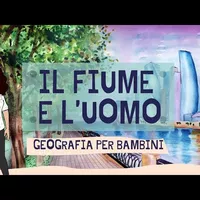IL FIUME - parte 2 - Geografia per bambini
the|river|part|Geography|for|children
THE|RIVER|part|Geography|for|children
DER FLUSS - Teil 2 - Geografie für Kinder
ΤΟ ΠΟΤΑΜΙ - μέρος 2 - Γεωγραφία για παιδιά
EL RÍO - parte 2 - Geografía para niños
LE FLEUVE - partie 2 - Géographie pour enfants
IL FIUME - parte 2 - Geografia per bambini
DE RIVIER - deel 2 - Aardrijkskunde voor kinderen
O RIO - parte 2 - Geografia para crianças
РЕКА - часть 2 - География для детей
SÔNG - phần 2 - Địa lý cho trẻ
THE RIVER - part 2 - Geography for children
Nehir - bölüm 2 - Çocuklar için coğrafya
il fiume e l'uomo geografia per bambini
the|river|and|the man|geography|for|children
the|nehir|ve|adam|coğrafya|için|çocuklar
der Fluss und der Mensch Geografie für Kinder
the river and man geography for children
nehir ve insan çocuklar için coğrafya
sin dall'antichità i fiumi hanno rappresentato una grande risorsa per l'uomo
||||||||Ressource||
sin(1)|since the antiquity|the|rivers|they have|represented|a|great|resource|for|man
itibaren|antik çağdan|(belirli artikel)|nehirler|(3 tekil çoğul yardımcı fiil)|temsil etmiştir|bir|büyük|kaynak|için|insan
Seit der Antike haben die Flüsse eine große Ressource für den Menschen dargestellt
since ancient times, rivers have represented a great resource for man
Antik çağlardan beri nehirler insan için büyük bir kaynak olmuştur
le popolazioni più antiche abitavano proprio lungo i fiumi infatti si chiamavano civiltà
||||lebten||||||||
the|populations|more|ancient|they lived|just|along|the|rivers|indeed|they|they were called|civilizations
(belirli artikel)|nüfuslar|daha|eski|yaşıyordu|tam olarak|boyunca|(belirli artikel)|nehirler|aslında|kendileri|adlandırılıyordu|medeniyetler
Die ältesten Völker lebten gerade entlang der Flüsse, sie wurden tatsächlich Zivilisationen genannt
the oldest populations lived right along the rivers, in fact, they were called civilizations
En eski topluluklar tam olarak nehirler boyunca yaşıyordu, bu nedenle medeniyet olarak adlandırılıyordu
perché le civiltà si sono sviluppate proprio lungo i corsi dei fiumi innanzitutto perché la
|||||entwickelt|||||||||
why|the|civilizations|they|they are|developed|precisely|along|the|courses|of the|rivers|first of all||the
çünkü|(belirli artikel)|medeniyetler|(refleksif zamir)|(3 tekil geçmiş zaman yardımcı fiil)|gelişmiş|tam olarak|boyunca|(belirli artikel)|akışlar|(belirli artikel)|nehirler|öncelikle|çünkü|(belirli artikel)
because civilizations developed right along the river courses, primarily because the
çünkü medeniyetler öncelikle nehirlerin kıyılarında gelişmiştir, çünkü
presenza di acqua rende i terreni fertili e quindi particolarmente adatti ad essere coltivati
|||||Boden|fruchtbar|||||||angebaut werden
presence|of|water|it makes|the|lands|fertile|and|therefore|particularly|suitable|to|to be|cultivated
varlığı|su|su|yapar||topraklar|verimli|ve|bu nedenle|özellikle|uygun||olmaya|ekilmeye
the presence of water makes the land fertile and therefore particularly suitable for cultivation
su varlığı toprakları verimli hale getirir ve bu nedenle tarıma özellikle uygundur.
inoltre i fiumi consentivano la navigazione e quindi gli spostamenti e gli scambi commerciali
moreover|the|rivers|they allowed|the|navigation|and|therefore|the|movements|||exchanges|commercial
ayrıca|(belirli artikel)|nehirler|izin veriyordu|(belirli artikel)|navigasyon|ve|bu nedenle|(belirli artikel)|hareketler|ve|(belirli artikel)|ticaretler|ticari
moreover, rivers allowed navigation and therefore movement and trade exchanges
Ayrıca nehirler, ulaşımı ve dolayısıyla ticari değişimleri mümkün kılıyordu.
infine lungo le rive dei fiumi la presenza di argilla permetteva la costruzione di mattoni,
finally|along|the|shores|of the|rivers|the|presence|of|clay|allowed|the|construction|of|bricks
nihayet|boyunca|belirli|kıyılar|(bir şeyin)|nehirler|belirli|varlık|(bir şeyin)|kil|izin veriyordu|belirli|inşaat|(bir şeyin)|tuğlalar
finally, along the banks of the rivers, the presence of clay allowed the construction of bricks,
Son olarak, nehir kenarlarında kil varlığı tuğla inşaatını mümkün kılıyordu.
vasi, utensili. I fiumi sono stati sempre importanti per la vita dell'uomo
containers|tools|the|rivers|they are|have been|always|important|for|the|life|of man
vazolar|aletler|(ben)|nehirler|(dır)|(geçmiş zaman)|her zaman|önemli|için|(belirli artikel)|yaşam|insanın
vases, tools. Rivers have always been important for human life
kaplar, aletler. Nehirler her zaman insan hayatı için önemli olmuştur.
e molte grandi città sorgono proprio lungo le loro rive
and|many|large|cities|they rise|right|along|the|their|shores
ve|birçok|büyük|şehirler|yükselir|tam|boyunca|onların|nehirler|kıyıları
and many great cities arise right along their banks
Ve birçok büyük şehir tam da kıyılarında yükselmektedir.
i fiumi sono importanti perché forniscono l'acqua sia per l'alimentazione umana e animale
the|rivers|they are|important|because|they provide|water|both|for|nutrition|human|and|animal
(belirtili nesne artı)|nehirler|(3 tekil)dir|önemlidir|çünkü|sağlarlar|suyu|hem|için|beslenme|insan|ve|hayvan
Rivers are important because they provide water for both human and animal consumption.
Nehirler önemlidir çünkü hem insan hem de hayvan beslenmesi için su sağlar.
sia per gli usi agricoli artigianali industriali. Spesso l'acqua dei fiumi viene condotta in
both|for|the|uses|agricultural|artisanal|industrial|Often|the water|of the|rivers|it is|conducted|into
hem|için|tarımsal|kullanımlar|tarımsal|zanaatkar|endüstriyel|Sık sık|su|ın|nehirler|gelir|yönlendirilir|içine
They are also used for agricultural, artisanal, and industrial purposes. Often, river water is channeled into
Aynı zamanda tarımsal, zanaat ve endüstriyel kullanımlar için de.
canali artificiali per farla arrivare anche ai campi più lontani. Anche molte industrie sono
canals|artificial|to|to make it|to arrive|also|to the|fields|more|far|also|many|industries|are
kanallar|yapay|için|onu|ulaşmak|ayrıca|en|tarlalar|daha|uzak|Ayrıca|birçok|sanayi|vardır
artificial canals to reach even the most distant fields. Many industries have also
uzak alanlara ulaşmasını sağlamak için yapay kanallar.
nate lungo i fiumi proprio per avere l'acqua necessaria per lavare e raffreddare gli impianti
||||||||||||kühlen||
born|along|the|rivers|just|to|to have|the water|necessary|to|to wash|and|to cool|the|plants
doğmuşlar|boyunca|belirli|nehirler|tam olarak|için|sahip olmak|su|gerekli|için|yıkamak|ve|soğutmak|belirli|tesisler
developed along rivers specifically to have the necessary water for washing and cooling production
Ayrıca birçok sanayi, tesisleri yıkamak ve soğutmak için gerekli suyu sağlamak amacıyla nehirler boyunca kurulmuştur.
di produzione. Alcuni fiumi sono navigabili e sono utilizzati come vie di comunicazione e per
|||||schiffbar|||||||||
of|production|Some|rivers|they are|navigable|and||used|as|ways|of|communication||for
üretim|production|Bazı|nehirler|dır|navigasyonlu|ve|dır|kullanılır|olarak|yollar|iletişim|iletişim|ve|için
plants. Some rivers are navigable and are used as communication routes and for.
Bazı nehirler gemiyle geçilebilir ve iletişim yolları ile mal ve insan taşımacılığı için kullanılır.
il trasporto delle merci e delle persone. L'uomo attraverso una macchina chiamata draga può prelevare
the|transport|of the|goods|and|of the|people|man|through|a|machine|called|dredger|can|to take
the|transportation|of the|goods|and|of the|people|The man|through|a|machine|called|dredger|can|extract
the transport of goods and people. Man, through a machine called a dredger, can extract
İnsan, drag adı verilen bir makine aracılığıyla su alabilir.
sabbia e ghiaia due materiali molto importanti per l'edilizia e cioè per la costruzione di
sand|and|gravel|two|materials|very|important|for|the construction||that is|for|the|construction|of
kum|ve|çakıl|iki|malzemeler|çok|önemli|için|inşaat|ve|yani|için|(belirli artikel)|inşaat|(belirli artikel)
sand and gravel, two very important materials for construction, that is, for the building of
inşaat için çok önemli iki malzeme, yani binaların ve konutların inşası için kum ve çakıl.
edifici e abitazioni. Ecco una draga o battello draga. Ecco riassunte le attività principali
|||||||Baggerschiff|||zusammengefasst|||
buildings|and|houses|Here is|a|dredger|or|boat|||summarized|the|activities|main
binalar|ve|konutlar|İşte|bir|kazıcı|ya da|bot|kazıcı|İşte|özetlenmiş|(belirli artikel)|faaliyetler|ana
buildings and homes. Here is a dredger or dredging boat. Here are summarized the main activities
İşte bir dragalama teknesi. İşte insanın ana faaliyetleri özetlenmiştir.
dell'uomo, l'agricoltura, l'estrazione di sabbia e ghiaia, la produzione di energia elettrica
of man|agriculture|the extraction|of|sand|and|gravel|the|production|of|energy|
insan|tarım|çıkarma|-den|kum|ve|çakıl|-ı|üretim|-den|enerji|elektrik
of man: agriculture, the extraction of sand and gravel, the production of electric energy
Tarım, kum ve çakıl çıkarımı, dağlardan inen suyun gücünden yararlanarak elektrik üretimi.
sfruttando la forza dell'acqua che scende dalle montagne. Lungo le rive dei fiumi è molto praticata
exploiting|the|force|of the water|that|comes down|from the|mountains|Along|the|banks|of the|rivers|it is|very|practiced
yararlanarak|(belirli artikel)|güç|su|ki|düşen|(den)|dağlar|Boyunca|(belirli artikel)|kıyılar|(den)|nehirler|(dır)|çok|uygulanan
by harnessing the power of water that flows down from the mountains. Along the banks of rivers, it is widely practiced.
Nehir kenarlarında bu çok yaygındır.
la pesca sportiva. In Abruzzo è possibile andare in canoa e godersi le acque cristalline del fiume
the|sport fishing|sporting|In|Abruzzo|it is|possible|to go|in|canoe|and|to enjoy|the|waters|crystal clear|of the|river
(belirtili artikel)|balık tutma|spor|(edat)|Abruzzo|(fiil)|mümkün|gitmek|(edat)|kano|ve|keyfini çıkarmak|(belirtili artikel)|sular|kristal gibi|(edat)|nehir
sport fishing. In Abruzzo, it is possible to go canoeing and enjoy the crystal-clear waters of the river
spor balıkçılığı. Abruzzo'da kano yapabilir ve Tirino nehrinin kristal berraklığındaki sularının tadını çıkarabilirsiniz.
Tirino. Il fiume Tirino è considerato il più limpido d'Europa. Il fiume più lungo d'Italia si
|||Tirino-Fluss||||||||||||
Tirino|The|river||it is|considered|the|most|clear|of Europe||||long|of Italy|it
Tirino|The|river|Tirino|is|considered|the|most|clear|in Europe|The|river|most|long|in Italy|it
Tirino. The Tirino River is considered the clearest in Europe. The longest river in Italy is
Tirino. Tirino Nehri, Avrupa'nın en berrak nehridir. İtalya'nın en uzun nehrinin adı
chiama Po e nasce nelle Alpi ad oltre 2000 metri di altitudine. Durante il suo corso incontra ben
he calls|Po|and|he is born|in the|Alps|at|over|meters|of|altitude|During|the|his|course|he meets|well
çağırır|Po Nehri|ve|doğar|içinde|Alpler|üzerinde|2000|metre|yükseklik|yükseklik|Sırasında|bu|onun|akış|karşılaşır|iyi
called Po and originates in the Alps at over 2000 meters above sea level. During its course, it meets as many as
Po'dur ve 2000 metreden fazla yükseklikteki Alplerde doğar. Akışı boyunca tam olarak
141 affluenti. Termina la sua corsa nel mar Adriatico con una foce a delta che si dirama
tributaries|It ends|the|its|course|in the|sea|Adriatic|with|a|mouth|at|delta|which|it|branches
akarsular|Biter|onun|kendi|akışı|da|deniz|Adriatik|ile|bir|ağız|delta||ki|o|dallanır
141 tributaries. It ends its journey in the Adriatic Sea with a delta mouth that branches
141 kolu ile karşılaşır. Adriyatik denizine delta şeklinde bir ağızla sonlanır.
in cinque bocche. Nei pressi della foce si trova il parco del Po che ha una presenza unica al mondo
||Mündungen|||||||||||||||||
in|five|mouths|Near|proximity|of the|mouth|it|it finds|the|park|of the|Po|which|it has|a|presence|unique|at the|world
içinde|beş|ağızlar|Yakın|çevresi|(belirli artikel)|ağız|kendisi|bulunur|(belirli artikel)|park|(belirli artikel)|Po Nehri|ki|var|bir|varlık|eşsiz|(belirli artikel)|dünya
into five mouths. Near the mouth is the Po Park, which has a unique presence in the world.
beş ağızda. Ağız yakınlarında, dünyada eşsiz bir varlığa sahip Po Parkı bulunuyor.
di animali e piante con oltre mille specie di piante e 449 specie di animali. Tra gli uccelli
of|animals|and|plants|with|over|thousand|species|of|plants|and|species|of|animals|Among|the|birds
hayvanlar|hayvanlar|ve|bitkiler|ile|üzerinde|bin|tür|hayvanlar|bitkiler|ve|tür|hayvanlar|hayvanlar|Arasında||kuşlar
of animals and plants with over a thousand species of plants and 449 species of animals. Among the birds
Binin üzerinde bitki ve 449 hayvan türü ile hayvanlar ve bitkiler.
ci sono molte specie rare come il fenicottero maggiore o fenicottero rosa, la sterna di Rupel
|||||||||||||Rupellseeschwalbe||Rüppellmöwe
there|are|many|species|rare|like|the|flamingo|greater|or||pink|the|tern|of|Rupel
var|vardır|birçok|tür|nadir|gibi||flamingo|büyük|veya|flamingo|pembe||kırlangıç||Rupel
there are many rare species such as the greater flamingo or pink flamingo, the Rupel tern
Kuşlar arasında, büyük flamingo veya pembe flamingo, Rupel martısı gibi birçok nadir tür var.
e la spatola. La destra del Po è una delle piste ciclabili più lunghe d'Italia. Costeggia il fiume
||Spachtel|||||||||||||entlang führt||
and|the|spatula||right|of the|Po|it is|a|of the|paths|cycling|more|long|of Italy|it runs along||river
ve|di|spatola|sağ|kıyısı|ın|Po Nehri|dir|bir|en|bisiklet yolları|bisiklet|daha|uzun|İtalya'nın|boyunca|ı|nehir
and the spoonbill. The right bank of the Po is one of the longest cycling paths in Italy. It runs along the river
Ve kaşıkçı. Po'nun sağ tarafı, İtalya'nın en uzun bisiklet yollarından biridir. Nehrin kıyısını takip eder.
Po lungo la riva destra per oltre 100 chilometri. Ma come fare a capire se la riva è destra o
Po|along|the|shore|right|for|over|kilometers|But|how|to do|to|to understand|if|the|shore|it is|right|or
Po|boyunca|belirli artikel|kıyı|sağ|için|100|kilometre|Ama|nasıl|yapmak|bir|anlamak|eğer|belirli artikel|kıyı|dir|sağ|ya
Po along the right bank for over 100 kilometers. But how can you tell if the bank is right or
Sağ kıyı boyunca 100 kilometreden fazla. Ama sağ kıyı mı yoksa
sinistra? Per capire se una riva o sponda sia di destra o di sinistra bisogna guardare nella
left|to|to understand|if|a|bank|or|shore|it is|of|right|||left|one must|to look|into the
sol|için|anlamak|e|bir|kıyı|veya|kenar|olup|sağ|sağ|veya|sağ|sol|gerekir|bakmak|içinde
left? To determine whether a bank or shore is right or left, you need to look at the
sol kıyı mı olduğunu nasıl anlayacağız? Bir kıyının ya da bankanın sağ mı yoksa sol mu olduğunu anlamak için suyun aktığı
direzione in cui scorre l'acqua. Bisogna cioè dare le spalle alla sorgente e guardare in direzione
direction|in|which|flows|the water|One must|that is|to give|the|back|to the|source|and|to look|into|direction
yön|içinde|hangi|akar|su|Gerek|yani|vermek|ona|sırtlar|kaynağa|kaynak|ve|bakmak|içinde|yön
the direction in which the water flows. You need to turn your back to the source and look in the direction
yöne bakmak gerekir. Yani kaynak tarafına sırtınızı dönüp,
della foce. A questo punto alla tua destra avrai la riva destra e alla tua sinistra la riva sinistra.
of the|mouth|At|this|point|to the|your|right|you will have|the|bank|||||left|||
nehrin|ağzı|Bu|bu|nokta|sağda|senin|sağ|olacak|o|kıyı|sağ|ve|solda|senin|sol|o|kıyı|sol
of the mouth. At this point, to your right you will have the right bank and to your left the left bank.
ağzına doğru bakmalısınız. Bu noktada sağınızda sağ kıyı, solunuzda ise sol kıyı olacaktır.
Qualche volta il fiume riceve talmente tanta acqua che può straripare, cioè la sua acqua
||||||||||über die Ufer treten||||
sometimes|time|the|river|receives|so much|much|water|that|can|overflow|that is|the|its|
Bazen|kez|o|nehir|alır|o kadar|çok|su|ki|-bilir|taşmak|yani|o|onun|su
Sometimes the river receives so much water that it can overflow, meaning its water
Bazen nehir o kadar çok su alır ki taşabilir, yani suyu
fuoriesce dal letto e allaga il territorio circostante provocando anche gravi danni. Per
||||überschwemmt||||||||
it emerges|from the|bed|and|it floods|the|territory|surrounding|causing|also|serious|damages|For
dışarı çıkıyor|dan|yatak|ve|su basıyor|o|bölge|çevre|neden olarak|ayrıca|ciddi|zararlar|için
exits its bed and floods the surrounding area, causing serious damage as well. To
yatağından çıkarak çevresindeki alanı sular ve ciddi hasarlara yol açar. Bunu
evitarlo gli uomini costruiscono gli argini, cioè dei grandi accumuli di terra lungo le
|||||Dämme||||Erdaufschüttungen||||
to avoid it|the|men|they build|the|levees|that is|of the|large|accumulations|of|earth|along|the
onu önlemek|onlara|insanlar|inşa ederler|onlara|bentler|yani|bazı|büyük|yığınlar|toprak||boyunca|
prevent this, people build embankments, which are large accumulations of earth along the
önlemek için insanlar setler inşa eder, yani nehrin kenarları boyunca büyük toprak yığınları.
o sponde del fiume. Il fiume è molto importante per la vita dell'uomo ed è dunque altrettanto
or|banks|of the|river|The||it is|very|important|for|the|life|of man|and|it is|therefore|equally
veya|kıyıları|ın|nehir|Bu|nehir|dir|çok|önemlidir|için|ın|yaşam||ve|dir|dolayısıyla|eşit derecede
or riverbanks. The river is very important for human life and it is therefore equally
Nehir, insan hayatı için çok önemlidir ve bu nedenle aynı şekilde
importante tutelare e salvaguardare l'ambiente fluviale, un fattore indispensabile per la vita
|schützen||||||||||
important|to protect|and|to safeguard|the environment|riverine|a|factor|essential|for|the|life
önemli|korumak|ve|güvence altına almak|çevre|nehir|bir|faktör|vazgeçilmez|için|yaşam|
important to protect and safeguard the river environment, an essential factor for life
nehir çevresini korumak ve güvence altına almak önemlidir, bu yaşam için vazgeçilmez bir faktördür.
sul nostro pianeta.
on the|our|planet
üzerinde|bizim|gezegen
on our planet.
gezegenimizde.
SENT_CWT:ANo5RJzT=5.31 PAR_TRANS:gpt-4o-mini=1.93 SENT_CWT:AFkKFwvL=7.36 PAR_TRANS:gpt-4o-mini=2.07
en:ANo5RJzT tr:AFkKFwvL
openai.2025-02-07
ai_request(all=48 err=0.00%) translation(all=38 err=0.00%) cwt(all=542 err=0.74%)

